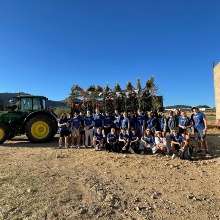Before we took part in an excursion to Spain in the fall of 2022 as part of our architecture and urban planning studies, none of us sixteen students knew what Chozos were, let alone the history and importance of transhumance for Spain and its population.
But this was soon to change, because on our excursion to the tranquil Cabeza del Buey in Extremadura, in central Spain, we learned from locals, shepherds and experts how to build Chozos with our own hands and how closely the way of life of the itinerant shepherds is interwoven with the history and tradition of the place.
Architecture on the move
"Chozo" is Spanish and means something like "(small) hut" or "little hut". For thousands of years, probably since Roman times, itinerant shepherds have been moving large herds of sheep and cattle several hundred kilometers across Spain from the winter to the summer pastures and vice versa. This movement, also known as "transhumance", forged an extensive system of cattle trails connecting the landscape from north to south. Chozos can be found all over the place there.
Chozos are part of an architecture that was created in a symbiosis of cultural and natural conditions. They were made of stone, wood or reed, depending on whether the shepherds took the huts with them as they moved from place to place or wanted to use them as permanent and fortified dwellings.
There are three different types of huts: Portable huts made of light plant material, massive stone huts that usually remained in place, and mixed huts with stone walls and reed roofs.
Learning from diverse cultures and traditions to inform and shape our future
There is a lot of knowledge in this vernacular architecture that is slowly being lost: The use of local resources, the efficient use of materials, integration into the landscape, consideration for nature and simple recycling. Even though the tradition is centuries old and has been slowly dying out since the 20th century, this know-how contains a lot of valuable and worthwhile knowledge for us architects of the next generation.
In view of the climate crisis and its consequences, which we humans have to deal with now and in the future, it has probably never been more important than now to plan and build in a way that conserves resources, is efficient and takes our environment into account. In addition to all the technical innovations and research into future ways of building, a look at the past and long-established traditions is also a worthwhile approach to responding to the crises of our time.
The project proved to be an enriching and formative experience for us students, a sentiment that still resonates more than a year later. We often talk to each other and to others about our experiences with the local people. One highlight that we have fond memories of is a traditional parade held in honor of the local patron saint—an authentic cultural experience that was truly incomparable. With 27 tractors, plenty of music, food, and drinks, we made our way from the village to a nearby location to spend the afternoon together, enjoying food and festivities. A visit to a cave with paintings from the Stone Age together with one of our guides was also unforgettable for us.
How do we want to live?
It is rare to be given the chance to experience ancient history so directly. Constructing the huts and working with our own hands and just a few simple tools has undoubtedly sparked an introspective process in all of us about our way of life and our approach to architecture. Perhaps it is more often the simple things that propel us forwards? Perhaps we need far fewer raw materials and luxury goods than we actually think in order to lead a good life? How can we strategize, construct, and inhabit the future in a way that safeguards our planet, promoting preservation and protection.
This trip was enriching for us in many ways. We are grateful that such experiences are made possible for us—above all, they enable us to grasp what is essential in our future profession and also for our personal development. They prompt us to consider which questions are relevant to us and the values we wish to embody.
Lilian
Comment on this article
Your email address will not be published.







